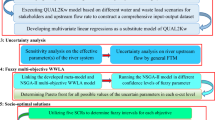Abstract
This paper presents an Interactive Fuzzy Multi-Objective Linear Programming (IFMOLP) model for water quality management in a river basin. The IFMOLP model formulated will first evaluate dissolved oxygen (DO) concentrations or DO deficits at a point in different reaches depending on the overall Biochemical Oxygen Demand (BOD) concentration present in the respective drain. Subsequently, the model incorporates the aspirations and conflicting objectives of the decision maker (DM) by taking into consideration the aspects relevant for pollution control boards as well as dischargers responsible for generating wastewater. The uncertainty associated with specifying the water quality criteria (based on DO concentration or DO deficit) and treatment cost to remove pollution level is incorporated by interacting the decision maker. In this process DM is asked to specify the reference aspiration levels of achievement for the values of all membership functions generated with respect to each objective. This provides flexibility for the pollution control authorities and dischargers to specify their aspirations. IFMOLP model developed herein is then used in a case study for the evaluation of optimal BOD removal in different drains located across the river Yamuna at New Delhi, India. The presented model will simulate the allocation of waste load efficiencies with satisfactory results which will indicate usefulness of the model in managing more complex river basins along with better flexible policies of water management.
Similar content being viewed by others
References
ADSORBS/32/1999-2000, Water Quality Status of Yamuna River. Assessment and Development of River Basin Series, Central Pollution Control Board, New Delhi
Bellman RE, Zadeh LA (1970) Decision-making in a fuzzy environment. J Management Science 17(4):B 141–B164
Ecker JG (1975) A Geometric Programming Model for the Optimal Allocation of Stream Dissolved Oxygen. J Management Science 21(6):658–668
Fuziwara O, Puangmaha W, Hanaki K (1988) River Basin Water Quality Management in Stochastic Environment. J Envir Engg Div Proc ASCE 114(4):864–877
Gils JAG van, Argiropoulos D (1991) Axios river basin water quality management. J Water Resources Management 5(3–4):277–280
Griensven AV, Francos A, Bauwens W (2002) Sensitivity analysis and auto-calibration of an integral dynamic model for river water quality. J Water Science & Technology 45(9):325–332
Jain SK, Singh VP (2003) Water Resources Systems Planning and Management. Elsevier, Singapore, pp 319–324
Klir GJ, Yuan B (1995) Fuzzy Sets and Fuzzy Logic: Theory and Applications. Prentice-Hall Inc, Englewood Cliffs NJ, pp 1–94, 390–416
Kotti ME, Vlessidis AG, Thanasoulias NC, Evmirdis NP (2005) Assessment of water quality in Northwestern Greece. J Water Resources Management 19(1):77–94
Koussis AD, Kokitkor P, Mehta A (1990) Modelling DO Condition in Stream with Dispersion. J Envir Engg Div, Proc ASCE 116(3):601–614
Lohani BN, Thanh NC (1978) Stochastic Programming Model Water Quality Management in a River. J WPCF 50(9):2175–2182
Loucks DP, Lynn WR (1966) Probabilistic Models for Predicting Stream Quality. J Water Resour Res 2(3):593.
Loucks, DP, (1983) Models for Management Applications. In: Orlob GT (ed), Mathematical Modeling for Water Quality: Streams, Lakes and Reservoirs, John Weley & Sons, New York, p. 468–509.
Mulligan AE, Brown LC (1998) Genetic Algorithms for Calibrating Water Quality Models. J Envir Engg Div Proc ASCE, 124(3):202–211.
O'Connor DJ, Dobbins WE (1956) The Mechanics of Reaeration in Natural Streams. J Sanitary Engg Div, Proc ASCE 82(SA6):1115–1–1115–30
Rodrigucz JF, Bombardelli F, García AMH, Frothingham KM (2004) High-resolution Numerical Simulation of Flow Through a Highly Sinuous River Reach. J Water Resources Management 18(3):177–199
Rowan PP, Jenkis KK, Howells DH (1961) Estimating Sewage Treatment Plant Operation and Maintenance Costs. J WPCF 47(2):111–124
Sakawa M (1993) Fuzzy Sets and Interactive Multiobjective Optimization. Plenum Press, New York
Sasikumar K, Mujumdar PP (1998) Fuzzy optimization model for water quality management of a river system. J Water Resour Plann Manage 124(2):79–88
Singh AP, Ghosh SK (2003a) Conceptual Modeling and Management of Water Quality in a River Basin. In: Ramanathan AL, Ramesh (ed), Recent Trends in Hydrogeochemistry, Capital Books, New Delhi, pp 207–220.
Singh AP, Ghosh SK (2003b) Uncertainty Analysis in River Basin Water Quality Management. In: Raju KS, Sarkar AK, Dash M. (ed), Integrated Water Resources Planning and Management, Jain Brothers, New Delhi, pp 235–246
Singh RK, Singh AP (2000) Application of Linear Goal Programming in Water Quality Management of a River Stretch. In: Dwivedi AP (ed), Mathematical Analysis and Applications, Narosa Publishing House, New Delhi, pp 288–294
Somlyody L (1997) Use of optimization models in River Basin Water Quality Planning. J Water Science and Technology 36(5):209–218
Tung, Yeou-Koung, Hathhorn WE (1989) Multiple-objective waste-load allocation. J Water Resources Management 3(2):129–140
Tung Yeou-Koung (1992) Multiple-objective stochastic waste-load allocation. J Water Resources Management 6(2):117–133
Wen CG (1989) Water Quality Management in Tseng-Wen River Basin. Taiwan, Proc IAWPRC Conf, Rovaniemi, Finland, pp 307–315
Zimmerman HJ (1978) Fuzzy Programming and Linear Programming with Several Objective Functions. Fuzzy Sets and Systems 1(1):45–55
Author information
Authors and Affiliations
Corresponding author
Rights and permissions
About this article
Cite this article
Singh, A.P., Ghosh, S.K. & Sharma, P. Water quality management of a stretch of river Yamuna: An interactive fuzzy multi-objective approach. Water Resour Manage 21, 515–532 (2007). https://doi.org/10.1007/s11269-006-9028-0
Received:
Accepted:
Published:
Issue Date:
DOI: https://doi.org/10.1007/s11269-006-9028-0




